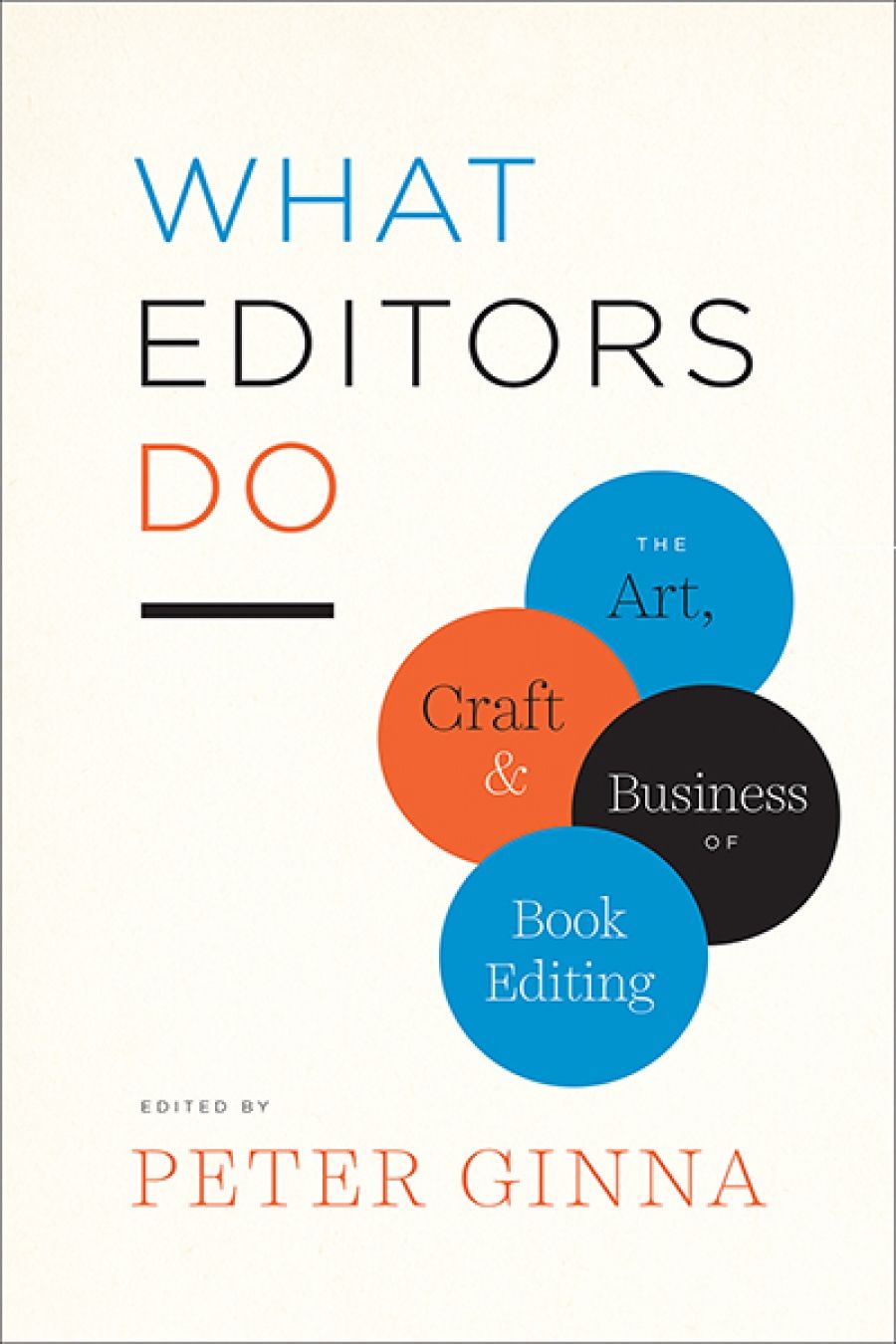
- Free Article: No
- Contents Category: Literary Studies
- Custom Article Title: Richard Walsh reviews 'What Editors Do: The art, craft, and business of book editing' edited by Peter Ginna
- Custom Highlight Text:
This is an American book and no doubt primarily aimed at those interested in how American publishing works, and specifically at those interested in gaining employment there or upgrading their skills. In Australia it will be of limited use to those with similar ambitions and interests, because the Australian ...
- Book 1 Title: What Editors Do
- Book 1 Subtitle: The art, craft, and business of book editing
- Book 1 Biblio: University of Chicago Press (Footprint), $54.99 pb, 320 pp, 9780226299976
Nonetheless, the contributors to What Editors Do offer illuminating insights into how large publishing houses operate and the kinds of texts they are looking to publish, no matter where they are located. Some of the contributions would be of particular interest to any budding Australian writer.
Peter Ginna, in his useful introduction, cautions writers who perceive publishers as baby murderers: ‘[They] don’t live to turn books down. They live to find books they believe in and to bring them to readers. Simply put: it is acquisitions, not rejection, that drives the engine of publishers.’ Many of the contributors emphasise what Ginna himself regards as one of the golden rules of acquisition: ‘Never buy a book unless you know who the audience for it is, and how you are going to sell it to them.’ Nancy Miller and Susan Rabiner, in particular, focus on what they perceive to be the essence of a publishable manuscript. Miller, who is editorial director at Bloomsbury, believes that at its most basic, for a non-fiction book to succeed, it needs to ‘have a reason to exist’.
Literary agent Rabiner describes that raison d’être as what she calls ‘conceptualization’, which she defines as: ‘the value added by the author to what is essentially a set of facts, stories, and commentary in search of a larger meaning ... It may be one he has taken, in some form, many times before. An author’s concept for the book is her promise that with the benefit of new research, new stories, new insights, and her authorial guiding vision, the reader will see new things on the journey and arrive at a new destination.’ Even with fiction: ‘If the novel is going to find a publisher, the author must convey what will make this story unique.’
A number of contributors make the point that authors are very focused on ‘good writing’, but sometimes reluctant to focus on the other factors that weigh with publishers. Ginna points out that the ideal proposal for any publisher is for it to be by an established author, on an exciting topic and beautifully written; but, more realistically, he admits that, in the immortal words of Meatloaf: ‘Two out of three ain’t bad.’ The corollary is that a manuscript by a newcomer that offers only beautiful writing is tiptoeing down a very challenging path.
Betsy Lerner, herself an author, recognises a basic truth: ‘Writers and editors have this in common: they are underdogs. The editor desperately wants to discover the next great novel. The novelist is desperate to be discovered.’
The excitement of the chase arises out of the desperation of publishing people to identify manuscripts that have real potential. Lerner describes it this way: ‘Acquisitions editors are in it for the high, for the feeling that something amazing is happening when they start to read fresh pages. Pheromones might even be involved. No matter how many manuscripts an editor reads, it is always there: the hope. This could be the book that hits the best-seller list, or wins a Pulitzer Prize, or, rarest of all, changes someone’s life.’
Most of us engaged in book publishing end up reading new submissions late at night, at the end of a long day during which we have probably grappled with a bombardment of editorial and marketing decisions. I always counsel my students never to read submissions simply as a chore – that is totally unfair on the authors concerned. If you cannot summon up the hope and expectation so eloquently expressed by Lerner, sooner or later you will allow a gem to fall through your fingers.
Producing a good piece of writing is always a worthwhile pursuit, whether the writing is fiction or a memoir or a polemic or whatever. If it is never published, that does not diminish its worth. But many writers never outgrow the idea that submitting a manuscript is like handing in an essay at school; they consider being rejected as literary failure. It isn’t.
Writing a book is a literary activity; submitting a manuscript to a publishing house is a commercial activity – even if the publisher is a university press or has financial patronage, it is still going to bear in mind how many readers are likely to respond positively. A book such as What Editors Do offers an excellent opportunity for would-be authors to see the world through the eyes of publishers/editors.


Comments powered by CComment